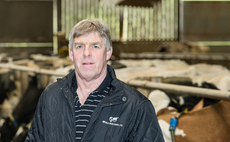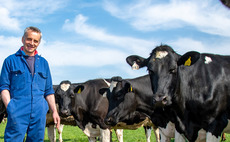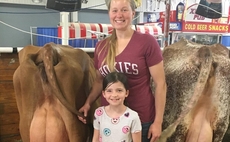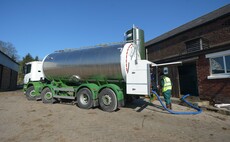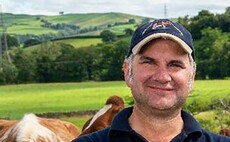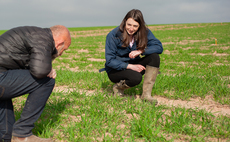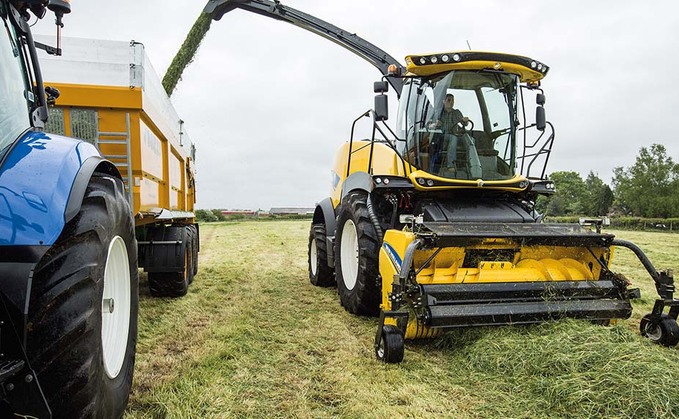
To keep on top of its silage workload, one Somerset contractor opted for New Holland's latest flagship forager, the 911hp FR920. Two seasons in, has it lived up to expectations? Geoff Ashcroft finds out.
For Somerset contracting family Butt Brothers, crop flow in combination with plenty of power, holds the key to forager output. "It is all about crop intake, feed angles and flow," explains Alan Butt who runs the business with his brother Keith and their sons Andy, Jake, Josh and Isaac. "It is no good having a big engine that cannot move crop through the inner workings of the forager. We should know, we have had a few of them over the years."
Since starting the contracting business in 1976 from Barrow Water Farm, Charlton Musgrove near Wincanton, the firm has enjoyed a succession of self-propelled machines, favouring John Deere models for many years. And with every change of machine, active demonstrations saw them try every brand on the market to ensure it chose the best machine for the job.
The FR920 is not the outfit's first New Holland. When it arrived for the 2019 season, it replaced an FR850. "The FR920 addressed all the short-comings we had with the FR850 and its predecessor, the FR9090," says Andy, who drives the flagship forager. "This latest version is a different animal to anything else we have had - in fact, it is the best model we have ever run."
Used with a 3m grass pickup, 6.2m Marangon folding whole crop header and a 12-row Kemper header for maize, the FR920 sees its way much through several thousand acres of foraging each season.
"It is comfortably 10-20 per cent better than the previous model," he says. "Crop flow is smooth, and the forager simply does not struggle to push material through the drum and into the trailers."
The FR920 Forage Cruiser is the flagship of New Holland's latest range and is powered by V8 FPT engine, developed with power and torque curves created to quickly deal with constantly changing crop loads.
This 20.1-litre, twin turbo motor develops 911hp, served up across a constant speed band from 1,800-2,000rpm. A hefty slug of torque arrives to reinforce that headline power, with a peak of 4,095Nm delivered at 1,500rpm - it is a 44 per cent rise from the FR920's 2,100rpm maximum revs.
In addition, a reconfiguration of machine components has enabled the forager to exploit the engine's potential. Crop intake is 12.5 per cent larger than its predecessor; feed rollers have been upgraded with more steel and an aggressive toothed profile and there is an extra gear in the intake gearbox that lets more power come through to the rollers. In all, New Holland says this results in a more consistent layer of forage presented to the drum.
An 884mm wide, chevron-patterned chopping cylinder takes care of business, and the firm's Variflow system makes it easy to swap between grass and maize configurations by bringing the crop accelerator closer to the drum when the crop processor is removed.
The Butts reckon it's a 20-minute task to remove the crop processor, and a two-hour job to swap a set of blades.
New Holland's Hydroloc chopping system affords two ranges for greater adjustment of chop lengths, and a larger pulley spins the cylinder at 1,300rpm, up from 1,130rpm.
Optional Dual Drive adds a separate hydraulic motor to the feed rollers offering greater fine-tuning of speeds, allowing the header and feed roll speeds to be controlled independently of each other.
For Andy, this level of controllability means sticky grass no longer has an opportunity to wrap around the feed rollers. "The amount of adjustment I now have at my fingertips is enormous," he says. "We get such a variation in grass - from volume, crop quality, moisture and even grass varieties - I now have the ability to fine-tune the forager wherever I go.
"It is rare that I will leave the settings untouched for two consecutive fields," he adds. "And the result is that throughput is effortless.
"The FR920 is no longer a machine that you could just put a driver on and lean on the stick," he says. "If you want to make the most of the forager's potential, you do need an understanding of what is going on, what you are picking up, and what you want to achieve. And of course, you still need a good team around you, to keep trailers and clamps operating efficiently."
This philosophy also translates into mowing and raking, to set the crop up for harvesting. The firm is in the process of gearing up its mowing capacity, by adding a Kuhn triple mo-co, and keeping its two John Deere front/rear 6m mower-conditioner combinations as back-up machines.
Depending on the season, swaths may be tedded to assist with drying, before a 15m Kuhn four-rotor rake pulls five rows into one. "Timing is everything when you are looking to make the best quality forage, and you cannot take advantage of conditions with small kit," he says.
"Many fields are simply not smooth, and with this level of performance, I want to keep my forward speed to around 10-15kph," says Andy. "Chain harrowing and rolling are low on the list of dairy farm priorities, so it is inevitable that we will consume three sets of blades and three shear bars each season. Regular sharpening is essential."
While Andy's fettling of machine settings translates into optimum output and performance for Butt Brothers Agricultural Contracting, the forager's 1,200-litre fuel tank is considered meagre. "Long days are commonplace, and the challenge of filling from a pump is just too slow, so we have fitted an extra tank to the rear of the forager," he says.
"The weight is handy on some of the steeper fields, but with a mechanical four-wheel drive system - rather than an assisted axle - it will go places where tractors and trailers sometimes cannot get. I have a diff-lock too, which can be handy in maize."
Making life easy in the cab is a foot-operated switch that Andy has fitted to take place of the joystick's shift key function, making it easy to toggle between spout raise/lower and chute flap adjustment. "There are times when opening up maize fields, that you just need less to do with your thumb," he says.
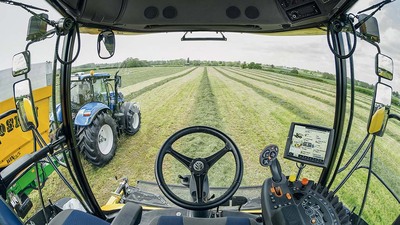
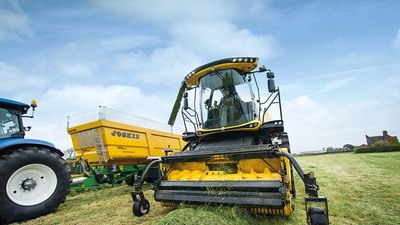
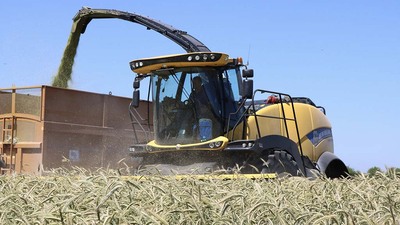
Verdict
Overall, Andy and the team are pleased with the FR920, but admits that there is still room for improvement.
"Cab noise levels are pleasant enough, and comfort is ok, though I would like a larger cab," he says. "And some of the automated features that have found their way onto this model are counter-productive."
He says the worst is its automated throttle reduction when the header is raised. "It is a frustration, so you learn to keep the header low to prevent auto-activation," he says. "I would like to see this function deleted - or made switchable, so I have the choice of when it happens. It is currently the one adjustment I cannot make."













